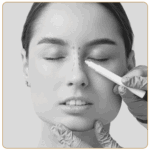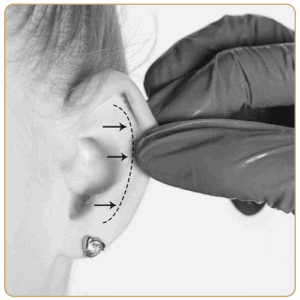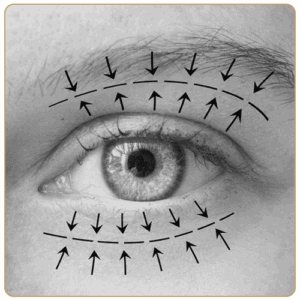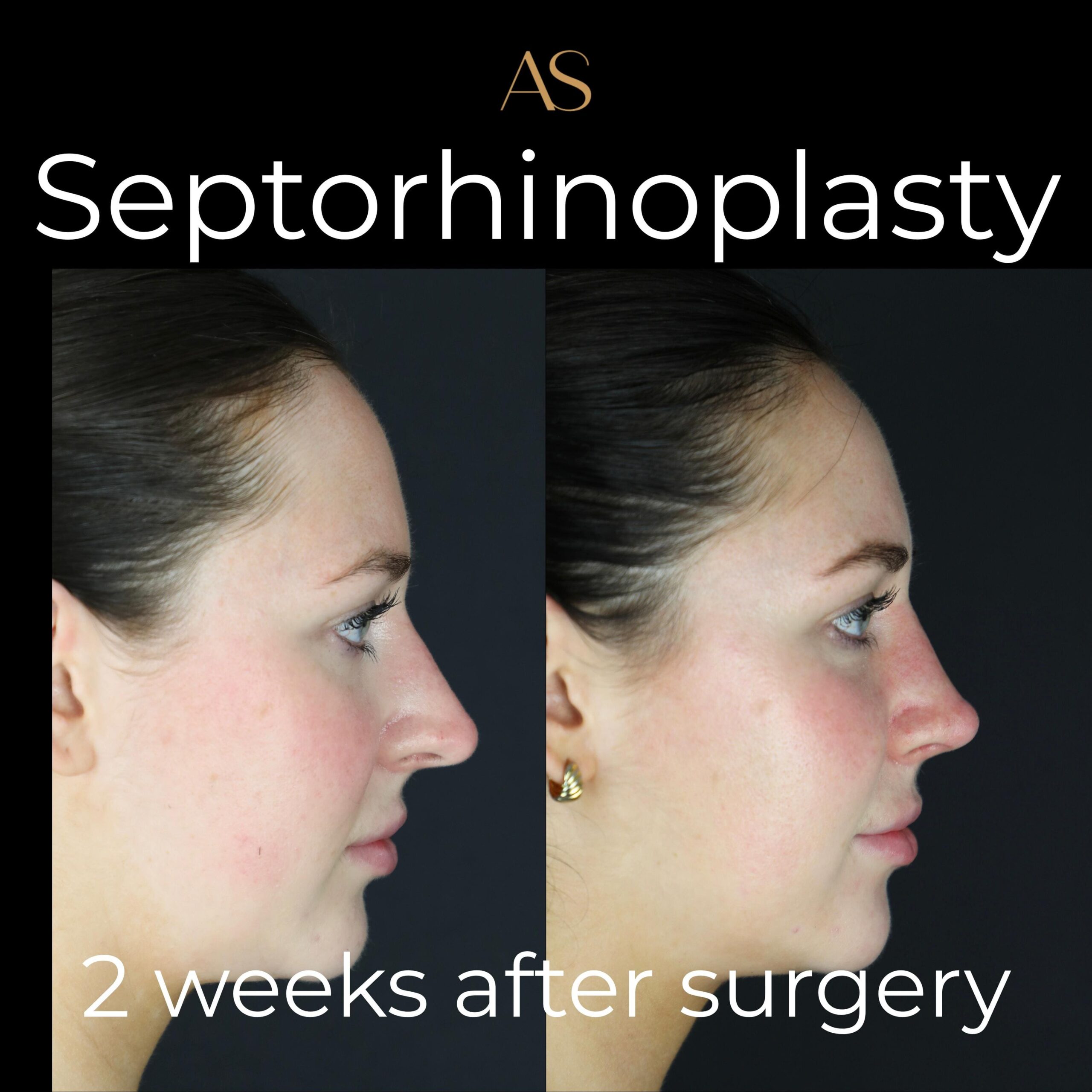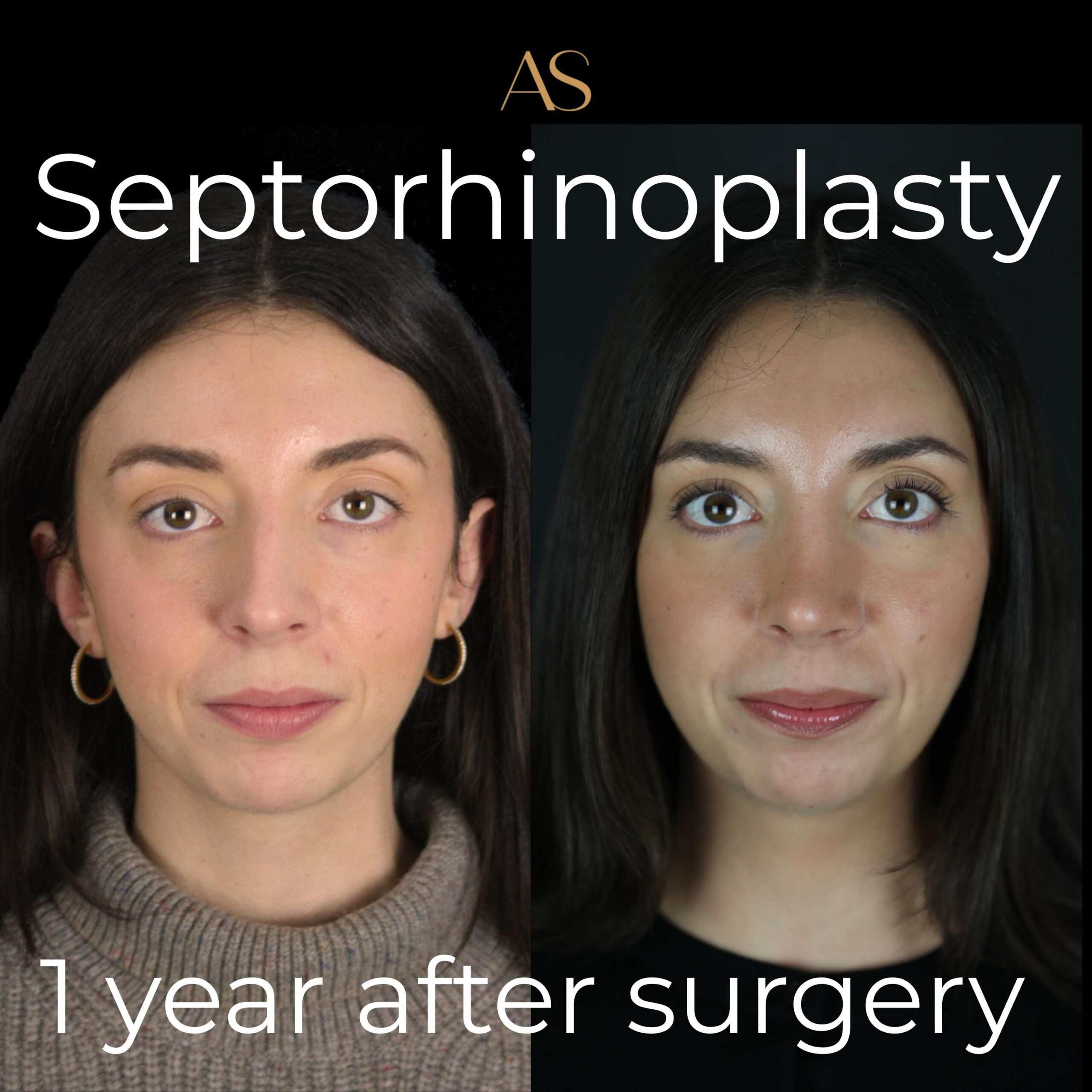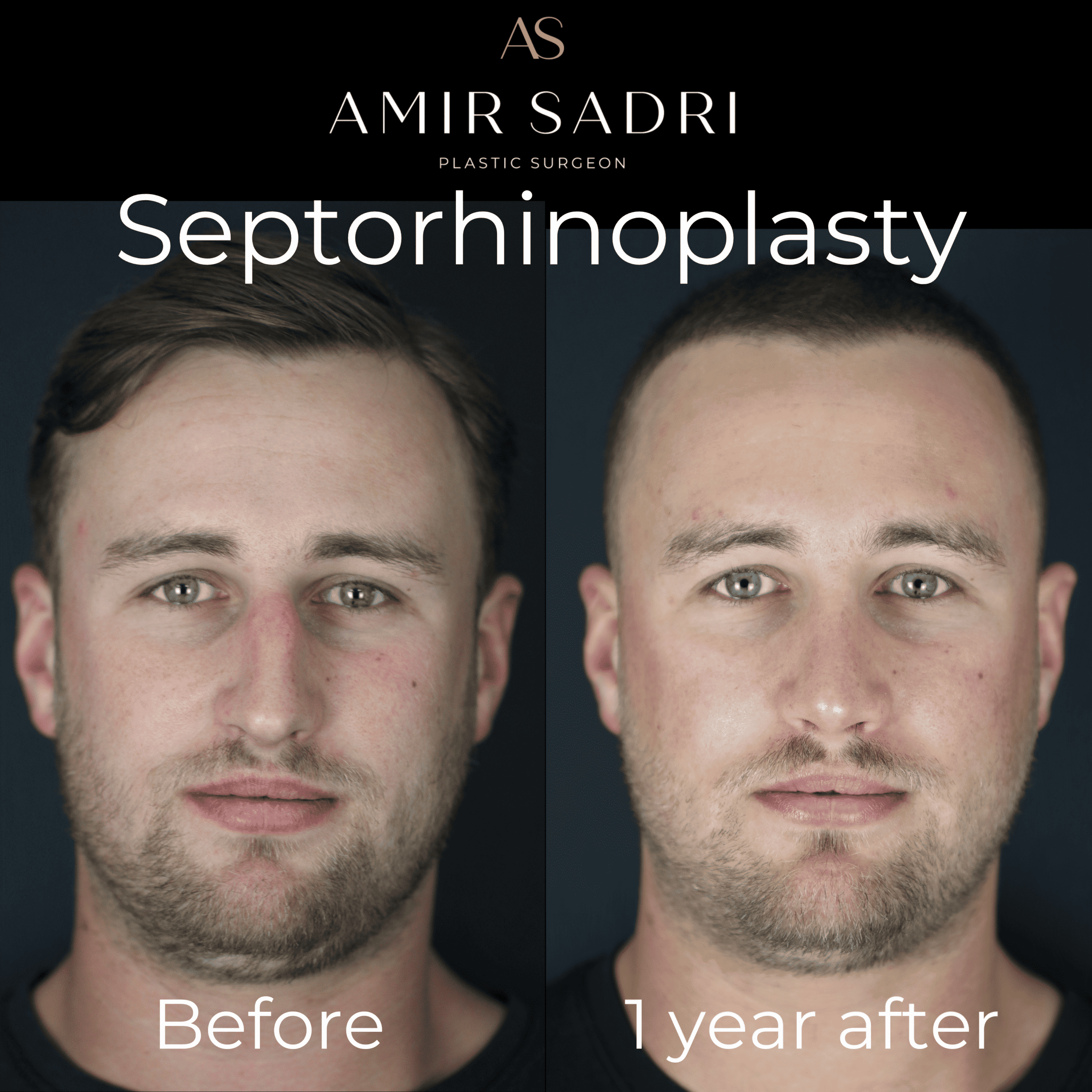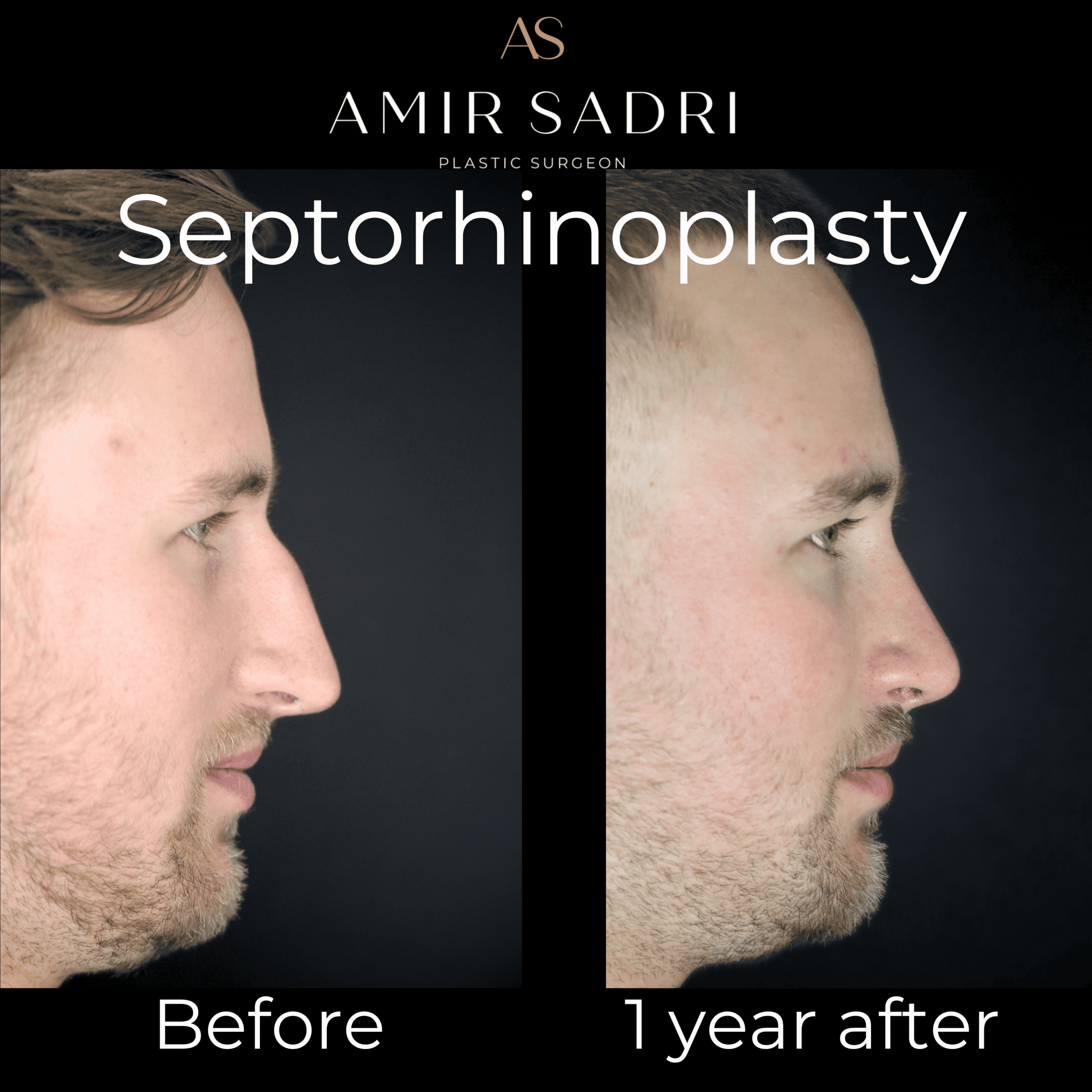Septorhinoplasty
Septorhinoplasty
Septorhinoplasty is a surgical procedure that combines two important aspects of nasal surgery: septoplasty and rhinoplasty. This complex procedure can help to improve both the function and aesthetics of the nose. If you’re considering septorhinoplasty for medical reasons, this comprehensive guide will provide you with all the information you need to make an informed decision about the surgery.
Septorhinoplasty is a surgical procedure that addresses both the internal structure (septum) and external appearance (nose shape) of the nose. This procedure is commonly performed by otolaryngologists (ear, nose, and throat specialists) and plastic surgeons. It is a versatile surgery that can address various nasal issues, ranging from medical concerns like breathing difficulties and other concerns.
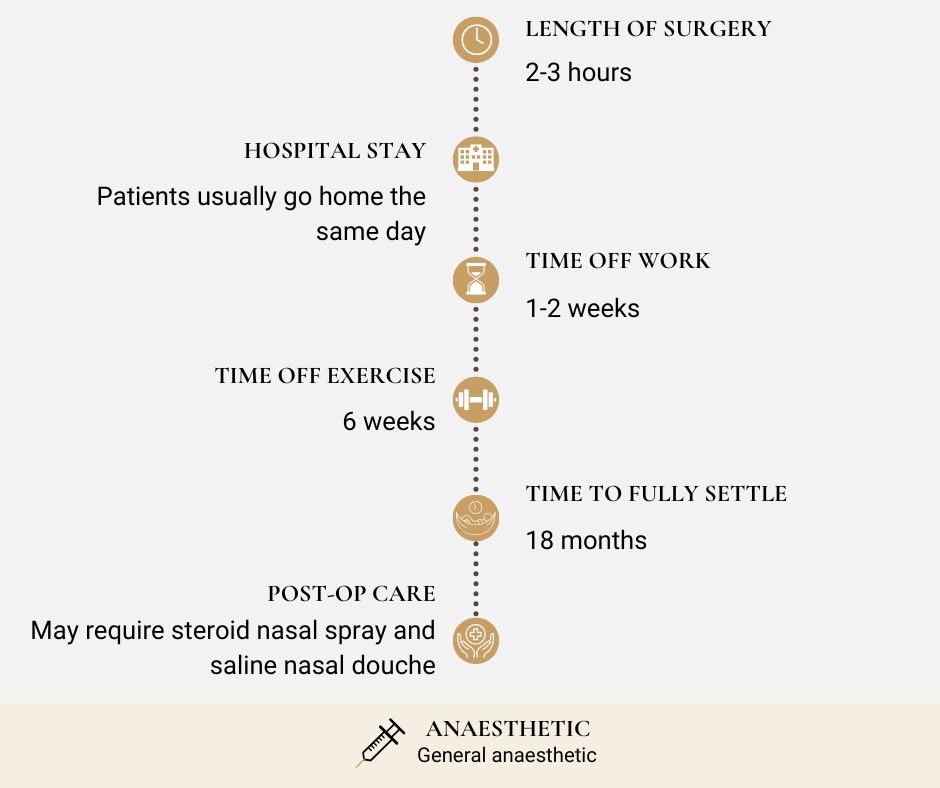
The benefits of Septorhinoplasty
Septorhinoplasty may be benefical for a number of reasons, these include:
Functional Issues: Septorhinoplasty can correct structural problems within the nose, such as a deviated septum, that obstruct airflow and cause breathing difficulties.
Trauma: In cases of nasal trauma or injury, septorhinoplasty can help restore the nose’s form and function.
Congenital Deformities: Some individuals are born with congenital nasal deformities. We can correct these issues through septorhinoplasty.
Combined Procedures: Often, we will combine septorhinoplasty with other facial procedures to achieve a harmonious facial appearance while addressing medical concerns.
Septorhinoplasty Surgery
Before undergoing septorhinoplasty, you will go through a comprehensive preoperative process, which includes:
Consultation:
You will meet with your surgeon to discuss your goals, medical history, and assess your suitability for the procedure. Your surgeon will also explain the risks, benefits, and expectations.
Physical Examination:
We will conduct a thorough examination of your nose and facial structure. This may include photographs, measurements, and nasal endoscopy to evaluate the internal nasal structure.
Medical Evaluation:
Your surgeon will review your medical history and may request additional tests, such as blood work and imaging, to ensure you are in good health for surgery.
Discussion of Expectations:
It’s essential to communicate your expectations and desired outcomes with your surgeon. Realistic expectations are crucial for satisfaction with the results.
Preoperative Instructions:
You will receive detailed instructions on preparing for surgery. This may include discontinuing certain medications, quitting smoking, and fasting before the procedure.
Online Consulting
Arrange a 15-minute call to discuss our treatments and services.
Before & After Gallery
The Septorhinoplasty Procedure
Septorhinoplasty is typically performed in a hospital or surgical center under general anesthesia or local anesthesia with sedation. The procedure can split into key steps:
Please click the toggle to learn about the Septorhinoplasty process.
The procedure
Incisions: Depending on the complexity of the surgery, we will make incisions on either inside the nostrils (closed approach) or across the columella (the narrow strip of tissue between the nostrils, open approach).
Septoplasty: The first step is septoplasty, where we will straighten the deviated septum, and remove any obstructions to improve airflow.
Rhinoplasty: The second step involves reshaping the external structure of the nose. This may involve reducing or augmenting the size, refining the tip, correcting asymmetry, or addressing other cosmetic concerns.
Sutures and Splints: After we make the desired changes, we will close the incisions with sutures, and nasal splints or we will pack the inside the nostrils to support the new nasal structure during the initial healing phase.
The duration of the surgery varies depending on the complexity of the procedure but typically ranges from one to three hours.
Recovery and Aftercare
The recovery period following septorhinoplasty is crucial for achieving the best results. Here are some key points to keep in mind:
Initial Recovery: You will likely experience some swelling, bruising, and discomfort in the days following surgery. Pain medication and cold compresses can help manage these symptoms.
Rest and Elevation: It’s essential to rest with your head elevated to reduce swelling. Avoid strenuous activities and keep physical exertion to a minimum during the early stages of recovery.
Follow-Up Appointments: You will have several follow-up appointments with your surgeon to monitor your progress and remove any splints or sutures.
Diet and Medication: Follow your surgeon’s instructions regarding your diet, medication, and any restrictions on activities like smoking.
Resuming Normal Activities: Most patients can return to work or school within one to two weeks, although will may ask you to avoid strenuous activities for several weeks to allow for complete healing.
Swelling and Final Results: It may take several months for the final results of septorhinoplasty to become apparent as residual swelling subsides. Patience is key during this phase.
Risks and Complications
As with any surgical procedure, septorhinoplasty carries some risks and potential complications. It’s important to be aware of these, although they are relatively rare. Risks and complications may include:
- Infection
- Bleeding
- Scarring
- Anesthesia-related complications
- Altered sensation in the nose or surrounding areas
- Unsatisfactory aesthetic results
- Revision surgery may be necessary in some cases
Expected Results
The results of septorhinoplasty can be highly rewarding, both functionally and aesthetically. Here’s what you can expect:
Improved Breathing: If you underwent septorhinoplasty for functional reasons, you should experience a significant improvement in your ability to breathe through your nose.
Enhanced Appearance: If you had cosmetic concerns, you will notice improvements in the shape and appearance of your nose. It may take some time for the full aesthetic benefits to become apparent due to post-surgical swelling.
Boosted Confidence: Many patients report increased self-confidence and satisfaction with their appearance after septorhinoplasty.
Natural-Looking Results: Skilled surgeons aim to achieve results that look natural and harmonious with your overall facial features.
Dr Amir Sadri – Specialist Nose Surgeon
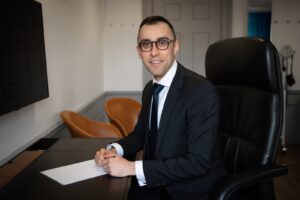
Septorhinoplasty is a versatile surgical procedure that addresses both functional and aesthetic concerns related to the nose. It offers patients the opportunity to improve their breathing and enhance their facial appearance simultaneously. If you’re considering septorhinoplasty, Please book a consultation. While the recovery process may require patience, the potential benefits and increased quality of life can make it a transformative experience for many individuals.
Septoplasty Recovery
Recovery time varies from person to person, but most individuals can expect to resume normal activities within a week or two after the procedure. Full recovery may take several weeks, during which the patient should follow the surgeon’s post-operative care instructions for optimal healing.
The recovery and aftercare following a septoplasty surgery are crucial for proper healing and optimal outcomes. Here are some general guidelines for septoplasty recovery and aftercare:
Rest and recovery
It’s important to rest and take it easy for the first few days after the surgery. Plan to take time off from work or school to allow your body to heal. Avoid strenuous activities, heavy lifting, and vigorous exercise during the initial recovery period.
Pain management
It is normal to experience some pain, swelling, and discomfort after septoplasty. Your surgeon may prescribe pain medications to manage any discomfort. Follow the prescribed dosage and instructions carefully. Applying cold compresses or ice packs to the nose and face can help reduce swelling and relieve pain.
Nasal care
Keep your nose clean and follow the specific instructions provided by your surgeon. Use saline nasal sprays or rinses as recommended to keep the nasal passages moist and help with healing. Avoid blowing your nose forcefully for the first week or as advised by your surgeon.
Nasal packing or splints
If your surgeon placed nasal packing or splints, they will provide instructions on when and how to remove them. This is typically done within a few days after the surgery. Follow their guidelines carefully to ensure proper healing.
Sleeping position
Sleeping with your head elevated on pillows can help reduce swelling and promote drainage. Try to sleep on your back rather than on your side or stomach during the initial healing phase.
Follow-up appointments
Attend all scheduled follow-up appointments with your surgeon. They will examine your progress, remove any packing or splints if necessary, and provide further instructions for your recovery.
Avoid certain activities and substances
During the recovery period, avoid activities that may put stress on your nasal area, such as contact sports or activities that involve risk of injury to the nose. It’s also important to avoid smoking and exposure to secondhand smoke, as they can impair healing and increase the risk of complications.
Be patient
Full recovery from septoplasty can take several weeks. It’s important to be patient and give your body the time it needs to heal. Follow your surgeon’s instructions, maintain a healthy lifestyle, and communicate any concerns or unusual symptoms to your medical provider.
Remember that these guidelines are general, and your surgeon may provide specific instructions tailored to your individual case. It’s essential to follow their advice for the best results. If you have any questions or concerns during your recovery, don’t hesitate to reach out to your surgeon or healthcare provider.
Online Consulting
Arrange a 15-minute call to discuss our treatments and services.


